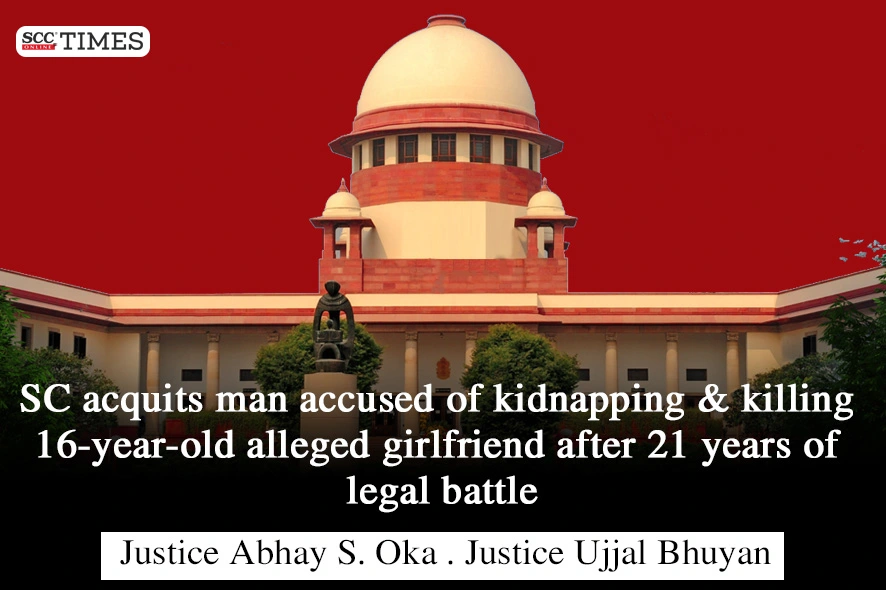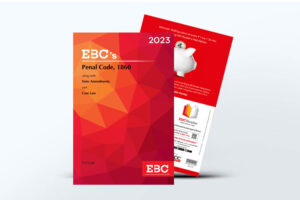Supreme Court: In a criminal appeal against the Gauhati High Court’s decision, whereby, the criminal appeal against the Trial Court’s decision convicting the accused under Sections 366(A)/302/201/34 of the Penal Code, 1860 (‘IPC’), was dismissed, the Division Bench of Abhay S. Oka and Ujjal Bhuyan*, JJ. allowed the appeal and set aside the impugned decision considering that none of the circumstances put forth by the prosecution to prove the guilt of the convict were proved. The complete chain of circumstances, to dispel any hypothesis of innocence of the convict was also incomplete.
Factual Matrix
On 26-08-2003, the father-complainant (PW-1) lodged a first information report (‘FIR’) stating that the convict herein, along with co-accused had kidnapped his minor daughter. The complainant alleged that his daughter had taken away Rs. 60,000 in cash from his house. It was further mentioned that mother of the convict told the complainant that the convict had kidnapped his daughter with the intention of marrying her. During the investigation, the dead body of the minor girl was found. Chargesheet was submitted against both the accused persons under Sections 366(A)/302/201/34 of the IPC.
The Trial Court convicted the convict and co-accused under Sections 366(A)/302/201/34 of the IPC. The convict was sentenced to suffer rigorous imprisonment (RI) for 5 years alongwith a fine of Rs. 3,000 with a default stipulation for the offence under Section 366(A) of the IPC. For the offence under Section 201 of the IPC, he was sentenced to undergo RI for 5 years alongwith a fine of Rs. 3,000, again with a default stipulation. The convict was also sentenced to undergo RI for life and to pay a fine of Rs. 3,000 with a default stipulation for the offence under Section 302 of the IPC.
Separate appeals were preferred by the convict and the co-accused. Vide the impugned judgment, the High Court set aside the conviction of the accused persons including that of the convict under Section 366(A) of the IPC but affirmed their conviction under Sections 302/201/34 of the IPC.
Analysis and Decision
The Court perused the statements of the prosecution witnesses, including the father’s examination-in-chief wherein he stated that the convict and the co-accused kidnapped his daughter and that the brother-in-of the convict and his mother informed the father that his daughter would return once the convict had married her. He also stated that his daughter had a love affair with the convict since last five years. At the time of the occurrence, the daughter was about 16 years of age.
Noting that the conviction at hand was based on conviction is based on circumstantial evidence, the Court referred to Ramu Appa Mahapatar v. State of Maharashtra, 2025 SCC OnLine SC 233 wherein, while dealing with the limitations of an extra- judicial confession which is one of the instances of circumstantial evidence held that circumstantial evidence is not direct to the point in issue but consists of evidence of various other facts which are so closely associated with the fact in issue that taken together, they form a chain of circumstances from which the existence of the principle fact can be legally inferred or presumed. The chain must be complete and each fact forming part of the chain must be proved. Where a case rests on circumstantial evidence, inference of guilt can be justified only when all the incriminating facts and circumstances are found to be incompatible with the innocence of the accused or the guilt of any another person.
In the matter at hand, the Court noted that the prosecution relied on three circumstances to prove the convict’s guilt. The three circumstances were- appellant and the victim were last seen together; extra-judicial confession made by the convict; and the fact of recovery of the dead body following the confessional statements of the convict.
The Court pointed out that the High Court discarded the circumstance of extra-judicial confessions made by the convict on the ground that those confessions were made in the presence of the police and thus were hit by Section 25 of the Evidence Act, 1872. Considering that the High Court had disbelieved one of the three circumstances put forth by the prosecution as part of the chain of circumstantial evidence to prove the guilt of the appellant, the Court stated that the chain of circumstantial evidence was not complete. As the chain got broken, the convict was entitled to the benefit of doubt as it could not be said that the circumstances put together established his guilt beyond all reasonable doubt.
The Court held that the High Court fell into error in holding the convict guilty on basis of the other two pieces of circumstantial evidence.
“When one of the three circumstances was disbelieved and discarded by the High Court, then the chain of circumstantial evidence could not have been held to be complete and proved and on that basis to hold the accused guilty of the offence. Each and every circumstance forming the chain of circumstantial evidence has to be proved.”
Circumstance of last seen together
The Court noted that the deceased’s friend PW-2 was the only witness who stated in her evidence that convict had forcefully taken the deceased away in a Tata Sumo when both of them were walking along the road. However, she also stated that the deceased had told her that she loved the convict. In her cross- examination, she stated that deceased had gone on her own accord and, therefore, she did not raise any hue and cry. The Court also noted that she stated that no money was seen in the hands of the deceased.
Further, the Court noted that mother and brother-in-law of the convict had come to the residence of deceased’s father and assured him that his daughter was safe and that they would arrange for their marriage. The Court said that for four days, the father did not lodge any complaint or first information though his daughter had gone missing. It was only on 26-08-2003 afternoon that the FIR was lodged and thereafter the dead body was recovered on the following day.
The Court stated that there were glaring discrepancies in the evidence of the witnesses who allegedly had seen the deceased last alive in the company of the convict on 22-08-2003. The Court pointed out that the dead body was recovered five days thereafter on 27-08-2003 that too after lodging of FIR on 26-08-2003.
The Court relied on State of Goa v. Sanjay Thakran (2007) 3 SCC 755, wherein, it was laid down that circumstance of last seen together would normally be taken into consideration when it is established by the prosecution that the time gap between the point of time when the accused and the deceased were found together alive and when the deceased was found dead is so small that possibility of any other person being with the deceased could completely be ruled out. In Kanhaiya Lal v. State of Rajasthan, (2014) 4 SCC 715, it was held that the circumstance of last seen together does not by itself lead to the inference that it was the accused who had committed the crime, there must be something more to establish the nexus between the accused and the crime. Applying the aforesaid principles, the Court stated that there was considerable time gap between the time the convict and the deceased were last seen together alive and recovery of the dead body.
Recovery of the dead body on confessional statements
“Section 26 of the Evidence Act says is that no confession made by any person while he is in the custody of a police officer shall be proved as against such person unless it is made in the immediate presence of the Magistrate. This is an exception to the absolute bar of Section 25 which declares that no confession made to a police officer shall be proved as against a person accused of any offence. Section 27 provides that when any fact is deposed to as discovered in consequence of information received from a person accused of any offence, in the custody of a police officer, so much of such information, whether it amounts to a confession or not, as relates distinctly to the fact thereby discovered, may be proved.”
The Court referred to Asar Mohammad v. State of Uttar Pradesh, (2019) 12 SCC 253, wherein, the Court referred to the word ‘fact’ appearing in Section 27 of the Evidence Act and held that such a fact need not be self- probatory. The word ‘fact’ is not limited to ‘actual physical material object.’ The Court reiterated that discovery of fact arises by reason that the information given by the accused exhibited the knowledge or the mental awareness of the informant as to its existence at a particular place which includes discovery of the object, the place from which it is discovered and the knowledge of the accused as to its existence.
The Court stated that the circumstance leading to discovery is intrinsically connected with the circumstance of extra-judicial confessions made by the convict and the other co-accused before the prosecution witnesses. The Court pointed out that the High Court had already rejected the circumstance of extra-judicial confessions as being in-admissible evidence. It was in the course of such extra- judicial confessions that the said prosecution witnesses mentioned about the information given by the accused persons leading to discovery of the dead body. The Court also found glaring inconsistencies in the prosecution witnesses statements leading to the discovery. Therefore, the Court held that the circumstance of leading to discovery was not proved beyond all reasonable doubt as against the convict. Hence, the Court stated that not only the chain of circumstantial evidence was incomplete, but all the circumstances also put forth by the prosecution to prove the guilt were also invalid pieces of evidence.
The Court also said that considering that the convict and the deceased were in love, there was no reason for the convict to murder the deceased, as there was no motive for the convict in the same. The Court added that the postmortem report has also ruled out recent sexual activity of the deceased.
Conclusion
The Court viewed that none of the circumstances put forth by the prosecution to prove the guilt of the convict were proved, not to speak of proving the complete chain of circumstances, to dispel any hypothesis of innocence of the convict. Hence, allowing the appeal, the Court set aside the impugned decisions, and acquitted the convict of the charges levelled against him and directed to release him.
CASE DETAILS
|
Citation: Appellants : Respondents : |
Advocates who appeared in this case For Petitioner(s): For Respondent(s): |
CORAM :






